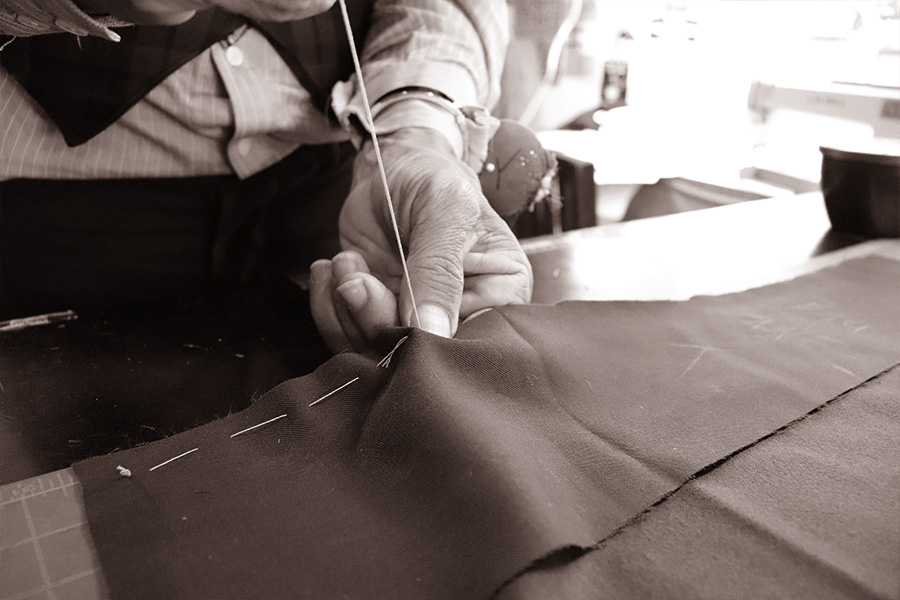Comprehending the Tailoring Process: From Material Option to Last Suitable for the Suitable Closet
The tailoring procedure is an intricate interaction of art and science, beginning with the critical choice of material choice and culminating in the exact modifications of final fittings. Each textile kind brings special qualities that affect not only the visual charm yet likewise the garment's long life and suitability for various occasions. Understanding the nuances of customizing strategies can elevate one's closet to unprecedented levels of elegance. As we check out these aspects additionally, one need to take into consideration how even the tiniest information can dramatically affect the overall result of one's personal design.
Significance of Textile Option
Selecting the best material is important in the customizing procedure, as it directly affects the comfort, longevity, and overall aesthetic of the final garment (tailor perth). The choice of material establishes the structure for the garment's style, performance, and functionality. Different fabrics possess special properties, such as stretch, breathability, and weight, which can substantially impact just how the garment drapes and fits the body
Furthermore, textile choice affects the garment's long life and convenience of treatment. Premium textiles can hold up against wear and tear, maintaining their look and structure in time, while lower-quality materials might bring about pilling or fading. In addition, the ideal textile contributes to the garment's capacity to change across occasions and periods, thus enhancing versatility.
A tailored piece made from an appropriate fabric not just showcases workmanship but also boosts the wearer's self-confidence. Comprehending the nuances of textile option is critical for any tailoring endeavor. It ensures that the end product not only satisfies the visual desires of the customer but likewise lines up with practical requirements, thus achieving an unified balance in between kind and feature in the tailored closet.
Sorts Of Fabrics and Their Uses
Understanding the various kinds of materials readily available is crucial for making notified choices throughout the tailoring procedure. Each fabric possesses one-of-a-kind qualities that dictate its viability for specific garments and events.
Its flexibility enables it to be customized right into every little thing from t-shirts to gowns. Its all-natural flexibility assists garments keep form over time.
Silk emanates luxury and is light-weight, making it excellent for eveningwear and delicate shirts; however, it calls for cautious handling because of its frailty. Bed linen, with its textured coating, is a popular choice for cozy climates, giving a crisp and ventilated feel, however it wrinkles quickly, which might influence the garment's look.
Artificial fabrics, such as polyester and nylon, offer sturdiness and resistance to creases, making them ideal for daily wear and energetic clothing. Comprehending these textile kinds and their homes permits much better decision-making, ensuring that each customized item not just fits well but likewise lines up with the intended function and occasion.
The Tailoring Techniques Described
The art of tailoring counts on a range of strategies that change material into well-fitted garments. Central to this procedure is pattern drafting, where a tailor develops themes based upon the customer's dimensions and wanted design. This preliminary step ensures that the garment will fit the wearer correctly prior to any type of cutting happens.
When patterns are developed, cutting strategies enter play. Accuracy is vital as mistakes can result in misfitting garments. Tailors commonly utilize various reducing techniques, such as single-layer reducing for elaborate styles and multiple-layer cutting for efficiency on typical patterns.
Basting is another important method, allowing dressmakers to briefly stitch textile assemble for an initial installation. This method offers the opportunity to analyze the drape and general shape before final stitching.
Seaming methods, including flat-felled joints and French joints, enhance the garment's sturdiness and aesthetic appeal. Tailors likewise employ strategies such as interfacing and padding to provide structure and form to details locations, like shoulders and collars.
Lastly, completing methods, including hemming and side completing, make certain the garment's long life while offering a sleek appearance. With each other, these methods develop the backbone of effective customizing, leading to beautiful, tailor-made garments.
Suitable Modifications and Factors To Consider

Trick factors to consider include the shoulder fit, which ought to neither droop neither limit activity, and the sleeve length, which should enable comfy arm activity while preserving a refined appearance. In addition, changes at the waistline can improve the silhouette, with choices to allow out or absorb material as required.
The rise of trousers is one more critical factor; it ought to rest conveniently over the hips without triggering discomfort, enabling simplicity of activity. Hemming sizes for both pants and skirts ought to reflect the user's preferred style while valuing percentages.

Keeping Your Tailored Clothing
Appropriate maintenance of tailored garments is crucial to protecting their fit and appearance over time. To make certain longevity, routine cleaning is critical. Constantly adhere to the care tag instructions, which may recommend link dry cleaning for delicate materials or machine cleaning for even more durable materials. Avoid constant laundering, as this can use down the textile and modify the garment's form.
Storage space is similarly vital; use cushioned wall mounts for coats and coats to maintain shoulder framework, and store trousers folded up neatly or hung to avoid creasing. Secure garments from direct sunlight, which can discolor colors and damages fibers.
In addition, routine evaluations for minor repairs can stop larger issues. Examine for loosened buttons, fraying joints, or indicators of moth damages, dealing with these troubles without delay to maintain the garment's integrity.
Finally, think about seasonal turning. Using customized pieces in small amounts allows textiles to recoup, extending their lifespan. By executing these maintenance methods, you can make sure that your tailored garments continue to be as excellent as the day you first wore them, improving your excellent closet for several years ahead.
Verdict
The customizing process, incorporating fabric choice, experienced strategies, and exact fitting adjustments, plays a vital function in producing garments that boost both comfort and read the full info here design. Recognizing the value of maintenance prolongs the life of customized garments, strengthening their worth in a well-curated closet.
Choosing the right fabric is important in the customizing procedure, as it straight affects the comfort, resilience, and total aesthetic of the final garment. The selection of material establishes the structure for the garment's performance, performance, and style. Various textiles have distinct properties, such as weight, stretch, and breathability, which can significantly affect exactly how the garment drapes and fits the body.
The art of tailoring relies on a range of techniques that transform fabric into well-fitted garments.The tailoring process, including material selection, competent methods, and specific suitable adjustments, plays a crucial function in producing garments that boost both comfort and style.